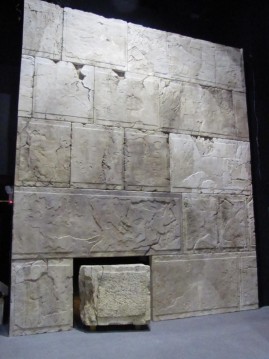
A fragment from the Book of War scroll, part of the Dead Sea Scrolls exhibit at the Cincinnati Museum Center.
Get thee to the Cincinnati Museum Center!
And do so in some haste, as the much-lauded Dead Sea Scrolls exhibit only has a few more weeks before it closes on April 14.
It’s an exhibit as much about biblical history in general as it is about the DSS in particular, walking visitors through millennia of the Ancient Near East. Like last year’s excellent Pompeii exhibit, there’s a strong emphasis on the artifacts of everyday life—jars, seals, coins, and the like. As the exhibit’s subtitle suggests, this is a look at “life and faith in ancient times,” much of it providing the context for understanding the scrolls, which don’t come until near the end of the exhibit.
Some observations:
1) This is a marvelous exhibit for adults and for older kids.
I brought my eighth-grader, who got pretty into it. If you are bringing school-age kids I highly recommend getting the audio tour, which is excellent. There are some interactive parts to the exhibit, like a large touch-screen station on the Ten Commandments, but for the most part the experience is geared toward an audience that’s content to read placards and learn from the audio experts. I wouldn’t bring a toddler or preschooler, but then again I am a Mom Wimp.
2) Monotheism was a great idea in theory, and not so prevalent in actual practice.
One of the most interesting parts of the exhibit was the archeological findings that showcased the discrepancy between what the Bible so clearly says (have no other gods before me, don’t worship idols, etc.) and what people in biblical times actually did. Judging by statues of fertility goddesses found in the ruins of Israelite homes, or the incense burners discovered in many other places besides the centralized/authorized worship in the Jerusalem temple, polytheism was alive and quite well, thank you. Apparently all those times when the Old Testament/Hebrew Bible carped on idol worship, it did so for a very good reason.
3) It’s really not a brilliant idea to use Scotch tape on ancient documents.
As the short film on the scrolls’ preservation will tell you, using Scotch tape on crumbling parchment never ends well. (Also, no smoking in the scriptorium, please.) Don’t miss this fascinating short documentary on how scholars preserved (indeed, hoarded) the scrolls—and how far conservationists’ techniques have come since the 1950s and 60s.
4) There is an unexpected emotional knockout from touching a piece of the Western Wall.
Yes, I’ve been to Israel, and yes, I saw the praying faithful at the Wailing Wall. I was moved by the sight, but was not permitted to approach the main portion of the wall myself, let alone touch it (that pesky vagina thing, see). So you can imagine my delight in getting to place my hands on a three-ton stone from the Wall, one that is believed to have fallen when the Romans destroyed the second temple in 70 CE. It’s one of the only ancient objects in the exhibit that guests are allowed to touch. If you stand there thinking of all the hopes and devastations that stone has known throughout its history, it’s hard not to resonate with the emotions connected with the past.
5) There is a strong Cincinnati connection to the Dead Sea Scrolls.
The last room of the exhibit was, quite unexpectedly, an homage to my fair city and its role in DSS research through many decades, primarily through Hebrew Union College. I was not aware of this story, and I won’t spoil it for you here, but the basic gist is that DSS research might yet be mired in internecine scholarly squabbles but for the bravery of one nerd armed only with linguistic software and a 1980s Apple computer. Up with underdogs!







